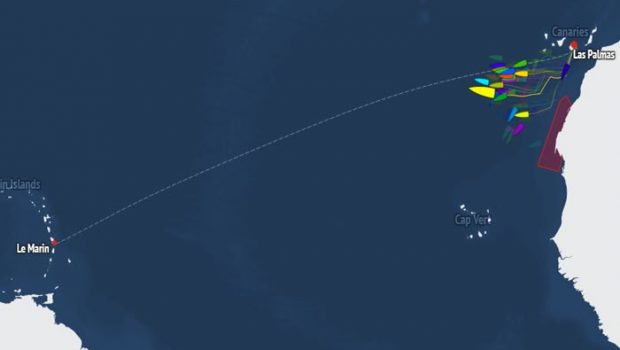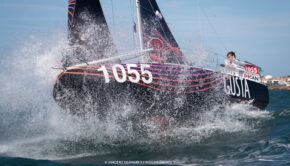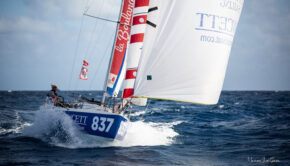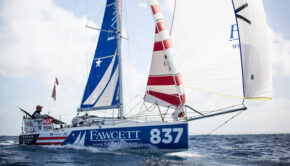Mini Transat: West or South?
Published on November 4th, 2019
(November 4, 2019; Day 3) – With few tools at their disposal, the second leg of the Mini-Transat finds the Mini 6.50 solo sailors having to decide which strategy they believe will pay off in the medium and long term: immediately favoring the West or investing in the South.
There’s been a high pace since start of the 2,700-mile passage from Las Palmas de Gran Canaria to Le Marin, in Martinique, and the fastest competitors have already covered nearly 500 miles along the great circle route (direct course). This evening, the leaders are Ambrogio Beccaria (production boat category) and François Jambou (prototypes).
Sailing in the trade winds is no bed of roses. The competitors are certainly posting good speeds downwind, but they’re having to deal with a shifty NE’ly wind both in terms of strength and direction (fluctuating a good twenty or so degrees throughout the day), in the knowledge that squalls may well color play. As a result, the skippers are having to make the most of these shifts and perfect the timing of their gybes.
Two major options are taking shape on the Atlantic chessboard. The bulk of the fleet has chosen to head West. This course is closer to the great circle route, but with it comes the risk of getting caught in zones with lighter winds. Other competitors have focused on making southing, lengthening the distance to sail in a bid to hunt down a steadier trade wind.
For them, the medium and long-term challenge hinges on whether the strength of the wind will compensate for the extra ground they must cover. The lateral separation between the competitors is constantly growing and this evening the fleet is split across 350 miles from Briton Joe Lacey (963 Earlybird Racing) in the North to Sébastien Liagre (589 Walaby) in the South.
After a little over two days of racing, certain sailors have already been a little deserted, as is the case for Raphaël Fortes (858), Georges Kick (529), and Sébastien Liagre (589). Already the solitude is absolute for them as they’re not in range of anyone else in the fleet.
Meantime, others are making headway within very compact groups, including Thibault Blanchet (774), Thomas D’Estais (819), Thomas Gaschignard (539), Jean Bachèlerie (428), and Pierre Casenave-Péré (857), who are likely sailing within sight of one another. At the 16:00 UTC position report, these four skippers were bunched within just 2 miles of one another.
In the prototype category, François Jambou (865), Tanguy Bouroullec (969), and Axel Tréhin (945) are right where you’d expect them to be, in the podium spot once again. At the 16:00 UTC position report, François held a rather precarious lead given that there is still over 2,200 miles to go. Erwan Le Méné (800) is also lying in ambush, determined to be in the mix to win this second leg to Martinique.
Event favorite and winner of the first leg, Ambrogio Beccaria is bringing his A Game once more. Since the start in Las Palmas, he’s been posting rapid speeds and pulling all the right moves. Benjamin Ferré (902), Keni Piperol (956), and Guillaume L’Hostis (868) are doing their utmost to hang on in there, on a similar course to that of the Italian. Their pursuers are scattered to the North, a posse led by Paul Cloarec (951), and a more substantial group to the South, with the notable presence of Félix de Navacelle (916).
The competitors sailing on the production scow bows are making the most of the conditions that favor their steeds to front the chasing pack. Keni Piperol, Paul Cloarec, and Guillaume Quilfen (977) are in the top ten. We also need to keep an eye on the southerly option adopted by Florian Quenot, who has been very quick since the start in Las Palmas. Indeed, he’s covered the greatest distance over the ground (prototype and production boats combined) with 608 miles devoured since the start (16:00 UTC today).
At 22:30 UTC last night, Marie Gendron completed the repairs to her spinnaker pole and keel fairing and headed back out to sea, eager to try and make up for lost time. Later this afternoon though, Jean Lorre arrived in El Hierro, the smallest island in the Canaries archipelago, where he’s hoping to resolve an issue with his stay chainplate. Jean will endeavour to make it as quick a pit stop as possible, in the knowledge that he must halt racing for at least 12 hours in line with the regulations that govern the race.
Ranking at 16:00 UTC:
PROTOTYPE
1. François Jambou (865 – Team BFR Marée Haute Jaune) 2,203.5 miles from the finish
2. Tanguy Bouroullec (969 – Cerfrance) 5.3 miles behind the leader
3. Axel Tréhin (945 – Project Rescue Ocean) 17.7 miles behind the leader
PRODUCTION
1. Ambrogio Beccaria (943 – Geomag) 2,206.3 miles from the finish
2. Benjamin Ferré (902 – Imago Incubateur D’aventures 16.4 miles behind the leader
3. Kéni Piperol (956 – Caraïbe Course Au Large) 34 miles behind the leader
Event details – Entry list – Tracker – Facebook
The biennial Mini-Transat La Boulangère has competition for the Mini 6.50 Class in two divisions: the prototypes and the production boats.
Production boats are built out of fiberglass, have alloy masts, 1.6 meter draft, and prohibit material such as titanium, carbon fiber, and epoxy resin. Ten boats must have been built to qualify as an official production boat.
Prototypes, on their side, are free of these restrictions and have been, for years, the very first laboratory for sailing innovations. Canting keels, daggerboards, swinging wing masts, long poles for huge spinnakers, have been tried first on minis. New hull shapes with very wide waterlines and foils are the now the latest innovations.
Race Format:
Eighty-seven started the first leg on October 5 (delayed from September 22 due to storms) from La Rochelle, France and extends 1350 nm to Las Palmas de Gran Canaria. After an often complicated exit of the Bay of Biscay, sailors will expect some long slips down the Portuguese coast before arriving after 7 to 10 days in the Canary archipelago.
Eighty-two started the second leg on November 2 from Las Palmas de Gran Canaria and will take from 15 to 20 sailing days to complete the 2700 nm course and reach Le Marin in Martinique, French West Indies. Due to the numerous islands, the restart from the Canary can be tricky before reaching the famous trade winds that offer a long downwind run.
Source: Effetsmer










 We’ll keep your information safe.
We’ll keep your information safe.